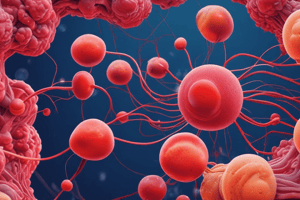Podcast
Questions and Answers
What is the role of intrinsic and extrinsic pathways in secondary hemostasis?
What is the role of intrinsic and extrinsic pathways in secondary hemostasis?
- They only function in the presence of the A antigen.
- They initiate the clotting cascade independently.
- They produce antibodies against the Rh factor.
- They converge at the common pathway to facilitate blood clotting. (correct)
Which of the following statements about blood groups is true?
Which of the following statements about blood groups is true?
- AB+ blood type has anti-A antibodies present.
- A- blood type does not have the Rh factor. (correct)
- O+ blood type has both A and B antigens.
- B- blood type can accept blood from A+.
Which blood type can a person with A- blood accept?
Which blood type can a person with A- blood accept?
- A+
- B+
- O- (correct)
- AB+
What antibodies are present in the blood of a person with blood type AB-?
What antibodies are present in the blood of a person with blood type AB-?
Which antigen is present in individuals with blood type B+?
Which antigen is present in individuals with blood type B+?
What is the primary function of hematopoiesis?
What is the primary function of hematopoiesis?
Which cell type is not derived from the Hematopoietic Stem Cell?
Which cell type is not derived from the Hematopoietic Stem Cell?
What is the main difference between primary and secondary hemostasis?
What is the main difference between primary and secondary hemostasis?
What initiates the process of platelet activation during primary hemostasis?
What initiates the process of platelet activation during primary hemostasis?
How do activated platelets recruit more platelets to the injury site?
How do activated platelets recruit more platelets to the injury site?
What role does fibrinogen play in the aggregation of platelets?
What role does fibrinogen play in the aggregation of platelets?
During the exposure phase of primary hemostasis, what substance binds to collagen?
During the exposure phase of primary hemostasis, what substance binds to collagen?
What is the first step of primary hemostasis that helps decrease blood loss?
What is the first step of primary hemostasis that helps decrease blood loss?
Flashcards
What is hematopoiesis?
What is hematopoiesis?
The process of producing blood cells, beginning with a hematopoietic stem cell and going through various stages to become different blood cell types.
Hematopoietic Stem Cell (HSC)
Hematopoietic Stem Cell (HSC)
A stem cell found in the bone marrow that can differentiate into all types of blood cells.
Common Myeloid Progenitor Cell (CMP)
Common Myeloid Progenitor Cell (CMP)
A specific type of progenitor cell that can differentiate into red blood cells, platelets, and some white blood cells.
Common Lymphoid Progenitor Cell (CLP)
Common Lymphoid Progenitor Cell (CLP)
Signup and view all the flashcards
Primary Hemostasis
Primary Hemostasis
Signup and view all the flashcards
Secondary Hemostasis
Secondary Hemostasis
Signup and view all the flashcards
How does endothelial injury decrease blood loss?
How does endothelial injury decrease blood loss?
Signup and view all the flashcards
What happens during adhesion in primary hemostasis?
What happens during adhesion in primary hemostasis?
Signup and view all the flashcards
Intrinsic Pathway of Coagulation
Intrinsic Pathway of Coagulation
Signup and view all the flashcards
Extrinsic Pathway of Coagulation
Extrinsic Pathway of Coagulation
Signup and view all the flashcards
Common Pathway of Coagulation
Common Pathway of Coagulation
Signup and view all the flashcards
Coagulation Factors
Coagulation Factors
Signup and view all the flashcards
Hemostasis
Hemostasis
Signup and view all the flashcards
Study Notes
Hematopoiesis
- Hematopoiesis is the formation of blood cells in the bone marrow.
- It's a sequential process starting from a single cell, progressing through stages of change.
- Substances in the blood guide cell differentiation, directing initial cells to form specific blood components (e.g., red blood cells or immune cells).
Hematopoiesis Pathway
- Hematopoiesis begins with a Hematopoietic Stem Cell (HSC).
- This cell branches into a Common Myeloid Progenitor (CMP) and a Common Lymphoid Progenitor (CLP).
- The CMP pathway leads to various myeloid cells like RBCs, Platelets, Neutrophils, Eosinophils, Basophils, Mast Cells, and Monocytes.
- The CLP pathway branches to lymphocytes (T cells, B cells, and NK cells).
Primary and Secondary Hemostasis
- Primary Hemostasis: Platelets clump together to form a plug at the site of injury.
- Secondary Hemostasis: The platelet plug is strengthened by a fibrin mesh.
Primary Hemostasis Steps
- Endothelial Injury: Vascular spasm reduces blood loss.
- Exposure: Collagen below endothelial cells is exposed. Von Willebrand factor binds to the exposed collagen.
- Adhesion: Circulating platelets bind to the von Willebrand factor via GP1B surface protein, attaching to the damaged area.
- Activation: Platelet shape changes, spreading out "tentacle-like arms". Platelets release substances attracting more platelets. ADP and Thromboxane A2 cause platelets to express GPIIA/IIIA, fully activating them.
- Aggregation: GPIIB/IIIA on platelets bind to fibrinogen, which can bind to multiple platelets, forming a clump.
Secondary Hemostasis
- (Diagram needed to understand the intrinsic and extrinsic pathways converging on a common pathway to form fibrin. The details of this are missing in the original text).
Blood Groups
| Blood Type | Antigens on Blood Cells | Antibodies in Blood | Rh Factor | Blood Types Acceptable |
|---|---|---|---|---|
| A+ | A | Anti-B | Yes | A-, A+, O- & O+ |
| A- | A | Anti-B | No | A-, O- |
| B+ | B | Anti-A | Yes | B-, B+, O- & O+ |
| B- | B | Anti-A | No | B-, O- |
| AB+ | A, B | None | Yes | All Blood Types |
| AB- | A, B | None | No | All blood type except AB+ and A+ |
| O+ | None | Anti-A, Anti-B | Yes | O-, O+, A-, A+, B-, B+ |
| O- | None | Anti-A, Anti-B | No | All Blood Types |
Studying That Suits You
Use AI to generate personalized quizzes and flashcards to suit your learning preferences.




